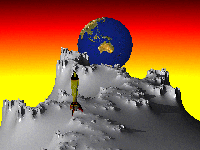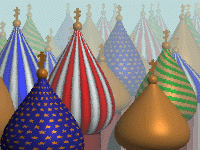
Maureen B Roberts:
![]() Schizophrenia Soul Therapy Helpline
Schizophrenia Soul Therapy Helpline
Jung Circle Members:
![]() Jung Circle Archives: Dreams, Reflections, Visions, Discussions
Jung Circle Archives: Dreams, Reflections, Visions, Discussions
![]() Myths, Tales, and Poems for the Jung at Heart
Myths, Tales, and Poems for the Jung at Heart
![]() Richardson's Clarissa, with a side of Jung
Richardson's Clarissa, with a side of Jung
Jung & the Imaginal Circle of "Erocentric" Vision
by Maureen B. Roberts, PhD
Jung Circle as Sacred Sphere . . . what does it mean? Different shades of being and becoming, dreaming and dissolving, deity and dedication to the many ways of many gods? A place where one collides and dances with the sacred soul of another, where 'the Centre cannot hold', yet where all whirls and drifts in peace and chaos about the Still Point that can never be fragmented nor destroyed? Where Mercurius is "I and the Not-I of Thou", angel and demon, solution and coagulated question, pancake and panacea, evasive yet all-pervasive, informing and cascading into a billion forms.
Temenos . . . a protected yet taboo land drawing many to its groves for a united "variety performance"; where dangerous plurality is compensated by the Uroboric cycle, where the play of opposites, protecting against splintering and splintering its protection, may safely face the unknown, the inferior, the interior, the familiar, the tragic, the magic, the fourth; where Self in its enclosed infinity is a circumference rayed with mandalic eyes and the seeds of rainbows, watered with fountains fetched from the four times four corners of quaternal soul (the more far-fetched and bizarre the better, as the Old Fool Jung says . . .)

For myself as artist and musician, shaman and writer, dreams and imaginative vision have always been the core ingredients of a quintessential reality, a boundless Circumference about whose Central axis I dance and limp the endless cycling of soul. Two of my central passions are, firstly, to help feed the myth-starved psyche and retrieve the World Soul; to do both by helping midwife the next phase of the incarnation of God, in which through bearing the tension of the opposites within ourselves, we shall know our Selves as indistinguishable from the paradoxical wholeness of the Divine. Secondly, I find fulfilment in inspiring or encouraging others to cherish and draw upon the wells of wisdom, vision and healing within them, to fearlessly embrace life's hunger for the sacred, wholistic yet polytheistic spectrum of soul, and to dance their own dance, to the tunes which they alone can hear.
As Jung made clear, we understand nothing psychologically unless we have experienced it, and what we experience not only transforms and moulds us, but, if we allow it to, also refines away the dross of non-essentials and allows to flow forth the individual essential whom we must embody if we are to live rich and authentic lives characterized by inner certainty and mythic continuity. Thus while all limiting belief systems are the province of the biased ego, individuation - as the natural and alchemical process of becoming all one has the potential to be - thrives on 'gnosis' as the direct experience of the collective unconscious, which as the union of all opposites, privileges neither pole of any duality. Dark and light, male and female, matter and psyche - each is implied in and thrives on the creative and (sometimes) destructive tension generated with its opposite.
Erocentric vs Homocentric Vision
As we rediscover and reinvent this new holistic vision of the psyche (or soul) in matter, and of matter in psyche, I believe that we will help birth a new consciousness in which Descartian mind-matter dualism will be superseded by a vision of life as an unbreakable continuum, a vast spectrum, each wavelength of which is a manifestation of the one universal Energy that informs all. I have named this vision 'Erocentric', since it is grounded in what Jung describes as the 'feminine principle' of Eros, as the intuitive ability to bind all together in a non-hierarchical web of relations.
Conversely, what I have called 'homocentric' (i.e. human-centred) ideologies, give central stage to humanity and its time-bound or social concerns, its philosophical prejudices and cultural biases, hence marginalize, or decentralize the interwoven and boundless wholeness of Cosmos and consciousness in which 'the Centre is everywhere'. My own musings on the topography of the mandalas which image this centred totality so concisely include the following: the closer we get to the Centre (Self), the less our consciousness identifies with one pole of any duality, hence at the Circumference I would place all ego perspectives (as beliefs, or "-isms", and including atheism as the opposite of theism). But as one moves away from the Circumference and circles toward the Singularity of the Centre, one simultaneously draws closer to the opposite pole. Hence the individuation process spirals inward through a gradual gradation - from Circumference to Centre - from one-sidedness (belief) toward an increasingly paradoxical awareness of the equivalence of opposites (gnosis); or as Jung has it: "The ego has to acknowledge many gods before it attains the centre where no god helps it any longer against any other god." (letter to Pastor Bernet, 13/6/1955)
I'm reminded also of Jung's comments on individuation and personality as the flow of Tao which "moves irresistibly towards its goal." Hence to rest in Tao, or in Jungian terms, to be centred in the Self, means "one's destination reached, one's mission done; the beginning, end, and perfect realization of the meaning of existence innate in all things." Here one has already arrived, since Self resides in the ubiquitous flow of timeless kairos, while the limited ego, if not subject to the Self, remains stuck in linear time and fixed space.
All visionaries, on the other hand, know that life is a holistic continuum such that, in the Romantic poet Keats' words, "Every department of knowledge we see excellent, and calculated towards a great whole." From within this holistic perspective we see that the theme of centrality, which orders binary stars, galaxies, solar systems, the psyche and atoms, also underlies the purpose and unity of imaginative vision.
There exist many primordial symbols for the origin, God and the soul, all of which express the intuition of a mysterious creative centre. The archetypal centre and circumference has appeared as a scientific idea in cosmology, in the notion of a timeless point - invisible and of no size, yet with infinite density - a central point from which the universe exploded into a vast circumference. Through the mirroring of mind and Nature, the Centre Point corresponds to the inner star-point of Gnosticism and alchemy, the "spark of the soul" or "spark of the divinity", which we must strive to incarnate as the Soul-making goal of human destiny and self-knowledge.
Thus we are each at the Centre, as is everywhere else. To be centred is to be self-circling on one's own teetering axis, to turn and twist in the uroboric dance at the pace of one's own heart, harming none, hindering none, connected to all yet a Cosmos and a law to oneself, feeling, as did the Soul-making poet, the giant agony of the world, adding the ocean drop of one's own compassion to help retrieve her sacred soul. For viewed within this spiralling circular perspective, Jungian individuation as the mythic journey toward wholeness is not primarily an intellectual construct but is rather an at times agonizing, at times blissfully self-transcending core experience which throughout history, and notably in the mystical traditions of both East and West, has under various guises referred to the same centring shift of consciousness in which one realizes one's deepest or innermost being as essentially unified, divine and inextricably linked to the whole. Examples of this core experience can be found in the Western mystical traditions of Platonism, alchemy and Gnosticism. Similarly, though, the Hindu Brahman, the Chinese Tao, the Shaivite Paramashiva, the Qabalistic En-Sof, the Sufi Truth and the Buddhist Void are all centring and unifying modes of knowledge and existence which transcend the dualities of inner and outer, human and divine. Accordingly, it is the power to embrace and transcend the extremes of existence in the wholistic consciousness of unus mundus that constitutes the overriding virtue of imaginative vision and - ultimately - Jungian individuation.
Text c.1998 by Maureen B. Roberts
Artwork: "A Landing on Mt. Mandelbrot" and "Onion Domes," both raytraced mathematical models by Bill Beaumont
Go to Jung Circle Home Page